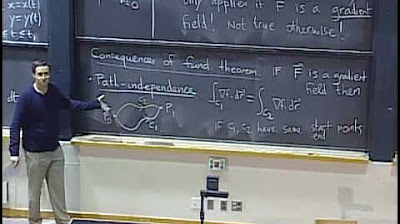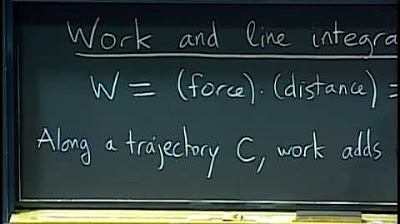Calculus 3: Line Integrals (Video #28) | Math with Professor V
TLDRThis calculus 3 lecture introduces line integrals, emphasizing the importance of parametrization for curves and orientation. The video covers how to parametrize curves, including circles with different orientations, functions, and line segments. It defines line integrals of scalar functions over curves, explains their physical interpretations, and demonstrates calculations with examples. The lecture also touches on line integrals of vector fields, particularly in the context of work done by a variable force along a curve, and concludes with an example of work calculation.
Takeaways
- 📚 The lecture introduces the concept of line integrals, emphasizing the importance of recalling parametrization of curves from previous calculus courses.
- 🔄 Parametrization of curves is crucial for line integrals, where the orientation of the curve is determined by the direction in which the parameter 't' increases.
- 📈 The lecture provides examples of how to parametrize a circle in both counterclockwise and clockwise orientations, highlighting the change in sign for the y-component to reverse orientation.
- 🤔 The process of parametrizing curves is reviewed, including the representation of curves with parametric equations and vector functions r(t) = <x(t), y(t)>.
- 📉 The video explains how to parametrize functions of the form y = f(x) and line segments, using direction vectors and restricting the parameter 't' to specific bounds.
- ∫ The definition of a line integral of a function over a curve is presented, involving partitioning the interval of the parameter 't', evaluating the function at representative points, and taking the limit as the partition becomes finer.
- 📏 The concept of 'ds', representing an infinitesimal arc length, is explained, and its relation to the derivative of the parametrization is discussed.
- 🛠 The lecture demonstrates how to evaluate line integrals over curves by converting them into single-variable integrals with respect to the parameter 't'.
- 🔍 Two interpretations of line integrals are provided: as the area of a vertical fence on a curve with variable height, and as the mass of a thin wire with variable density.
- 🔄 The video also addresses line integrals over piecewise smooth curves and the process of evaluating these by summing the integrals over each smooth piece.
- 🔗 The script concludes with a discussion on line integrals of vector fields over curves, relating them to the concept of work done by a variable force along a curve.
Q & A
What is the main topic of this calculus video lecture?
-The main topic of this calculus video lecture is line integrals, including their parametrization, computation, and applications in various scenarios.
Why is it necessary to review parametrization of curves when studying line integrals?
-Reviewing parametrization of curves is necessary because it often helps in obtaining a parametric representation of a specified curve, which is fundamental for calculating line integrals.
What does parameterizing a curve impose on it?
-Parameterizing a curve imposes an orientation on it, which is the direction in which the values of the parameter t are increasing.
How can you parametrize a circle with a radius of 5 in a counterclockwise direction?
-You can parametrize a circle with a radius of 5 in a counterclockwise direction by letting x = 5 cosine t and y = 5 sine t, with t ranging between 0 and two pi.
What is the easiest way to change the orientation of a curve from counterclockwise to clockwise?
-The easiest way to change the orientation of a curve from counterclockwise to clockwise is to keep the x-component the same and change the sign of the y-component.
How can you parametrize a function where y is equal to f(x)?
-You can parametrize such a function by letting x = t and y = f(t), effectively using t as a dummy variable.
What is the process of parametrizing a line segment?
-To parametrize a line segment, you need to find the initial point, the terminal point, and the direction vector. Then, restrict the parameter t between 0 and 1, and use the initial point in the parametric equations.
What does the line integral of a function over a curve represent?
-The line integral of a function over a curve can represent the area of a vertical fence or curtain on the curve with a variable height given by the function, or it can represent the mass of a thin wire with variable density given by the function.
How is the differential arc length ds related to the parametric representation of a curve?
-The differential arc length ds is related to the parametric representation of a curve by ds = sqrt((dx/dt)^2 + (dy/dt)^2) dt, where dx/dt and dy/dt are the derivatives of x and y with respect to the parameter t.
What is the fundamental theorem for line integrals that the lecture mentions will be covered next?
-The fundamental theorem for line integrals, which will be covered in the next lecture, likely relates to the conditions under which line integrals are path-independent, similar to the fundamental theorem of calculus for single-variable integrals.
Outlines
📚 Introduction to Line Integrals and Parametrization
This paragraph introduces the concept of line integrals, emphasizing the importance of recalling parametrization of curves from previous calculus courses. It explains that parametrization often involves expressing x and y as functions of a single variable t, represented as a vector function r(t). The orientation of a curve is highlighted as crucial, dictated by the direction of increasing parameter values. The paragraph provides a review example of parametrizing a circle with a radius of 5, demonstrating both counterclockwise and clockwise orientations, and discusses the implications of changing the sign of the y-component on orientation.
🔍 Parametrization of Curves and Line Segments
The second paragraph delves deeper into parametrizing curves, particularly focusing on the process for functions where y is a function of x. It illustrates this with an example of a function y = x^2 + 5, showing how to express it parametrically using t as a dummy variable. The paragraph also covers parametrizing line segments, using the line segment from (2, 5) to (-3, 7) as an example. It explains the necessity of using a direction vector and restricting the parameter t to the interval [0, 1] to ensure the parametrization represents only the line segment and not the entire line. The importance of starting with the initial point for parametrization is also stressed.
📐 Understanding Line Integrals Over Curves
This paragraph introduces the process of integrating a function of several variables over a curve, assuming a parametric representation of the curve is available. It outlines the steps for partitioning the interval for the parameter t, selecting representative points for each partition, and evaluating the function at these points. The concept of arc length, denoted as delta s, is introduced as the increment for integration. The paragraph concludes with the formal definition of a line integral over a curve, including the limit process to sum up the contributions from each partition as the number of partitions approaches infinity.
📉 Evaluating Line Integrals with Examples
The fourth paragraph provides a practical approach to evaluating line integrals, starting with a simple example of integrating x and y over a line segment from (-1, 1) to (2, 3). It demonstrates the process of finding a parametric representation for the line segment, calculating ds, and setting up the integral with the appropriate limits. The paragraph also touches on the implications of changing the direction of the line segment on the evaluation of the line integral and introduces the concept of integrating with respect to x or y instead of arc length ds.
🌐 Line Integrals Over Curves in Three Dimensions
The fifth paragraph extends the concept of line integrals to three-dimensional space, discussing how to integrate a function over a curve in space. It explains the process of parametrizing a curve in three dimensions and the notation used for the line integral, including the use of ds as the magnitude of the derivative of the parametrization. The paragraph also revisits the special line integral form pdx + qdy, which represents work done by a force field, and introduces the idea of line integrals of vector fields over curves.
🔧 Work Done by Variable Forces as Line Integrals
This paragraph explores the concept of work done by variable forces, which are represented as vector fields, along a curve. It explains the process of partitioning the curve and approximating the work done on each segment by taking the dot product of the force vector with the unit tangent vector of the curve, multiplied by the arc length. The paragraph provides a definition for the work done by a vector field along a curve and illustrates it with an example of a vector field defined by components p, q, and r, showing how the line integral of the vector field components results in the work done.
🛠️ Examples of Line Integrals and Work Calculations
The seventh paragraph provides an example of calculating the work done by a vector field along a curve defined by y = x^2, from (-1, 1) to (2, 4). It demonstrates two methods for setting up and evaluating the line integral: one using the components of the vector field and the other using the dot product of the vector field with the derivative of the parametrization. The paragraph concludes with a visual representation of the curve, the vector field, and the calculated work done.
🔚 Conclusion and Preview of Fundamental Theorem for Line Integrals
The final paragraph wraps up the lesson on line integrals and gives a preview of the next topic, the fundamental theorem for line integrals. It emphasizes the importance of understanding line integrals and suggests that upcoming lessons will cover this key theorem, which is a significant concept in the study of line integrals.
Mindmap
Keywords
💡Line Integrals
💡Parametrization
💡Orientation
💡Vector Functions
💡Arc Length
💡Piecewise Smooth Curves
💡Variable Force
💡Work Done
💡Unit Tangent Vector
💡Vector Fields
Highlights
Introduction to the concept of line integrals and their importance in calculus.
Review of parametrization of curves and its necessity for line integrals.
Explanation of how orientation is imposed on a curve through parametrization.
Parametrization example of a circle with counterclockwise and clockwise orientation.
Method to parametrize a curve given a function y = f(x).
Parametrization of line segments and the importance of orientation.
Process of integrating a function over a curve using parametric representation.
Definition of the line integral and its mathematical representation.
Visualization of line integrals as the area of a vertical fence or the mass of a thin wire with variable density.
Evaluation of line integrals over line segments with examples.
Discussion on the impact of changing the direction of a line segment on the line integral's value.
Introduction to line integrals with respect to x or y instead of arc length ds.
Explanation of line integrals of vector fields and their relation to work done.
Process of calculating work done by a variable force along a curve.
Example calculation of work done by a vector field along a parabola.
The fundamental theorem for line integrals and its significance in upcoming lessons.
Transcripts
Browse More Related Video

Lec 20: Path independence and conservative fields | MIT 18.02 Multivariable Calculus, Fall 2007

Line Integrals of Scalar Functions (Introduction)

Lec 19: Vector fields and line integrals in the plane | MIT 18.02 Multivariable Calculus, Fall 2007

Conservative Fields & Path Independence (Vector Fields)

Calculus 3: Derivatives & Integrals of Vector Functions (Video #8) | Math with Professor V

Calculus 3: Green's Theorem (Video #30) | Math with Professor V
5.0 / 5 (0 votes)
Thanks for rating: